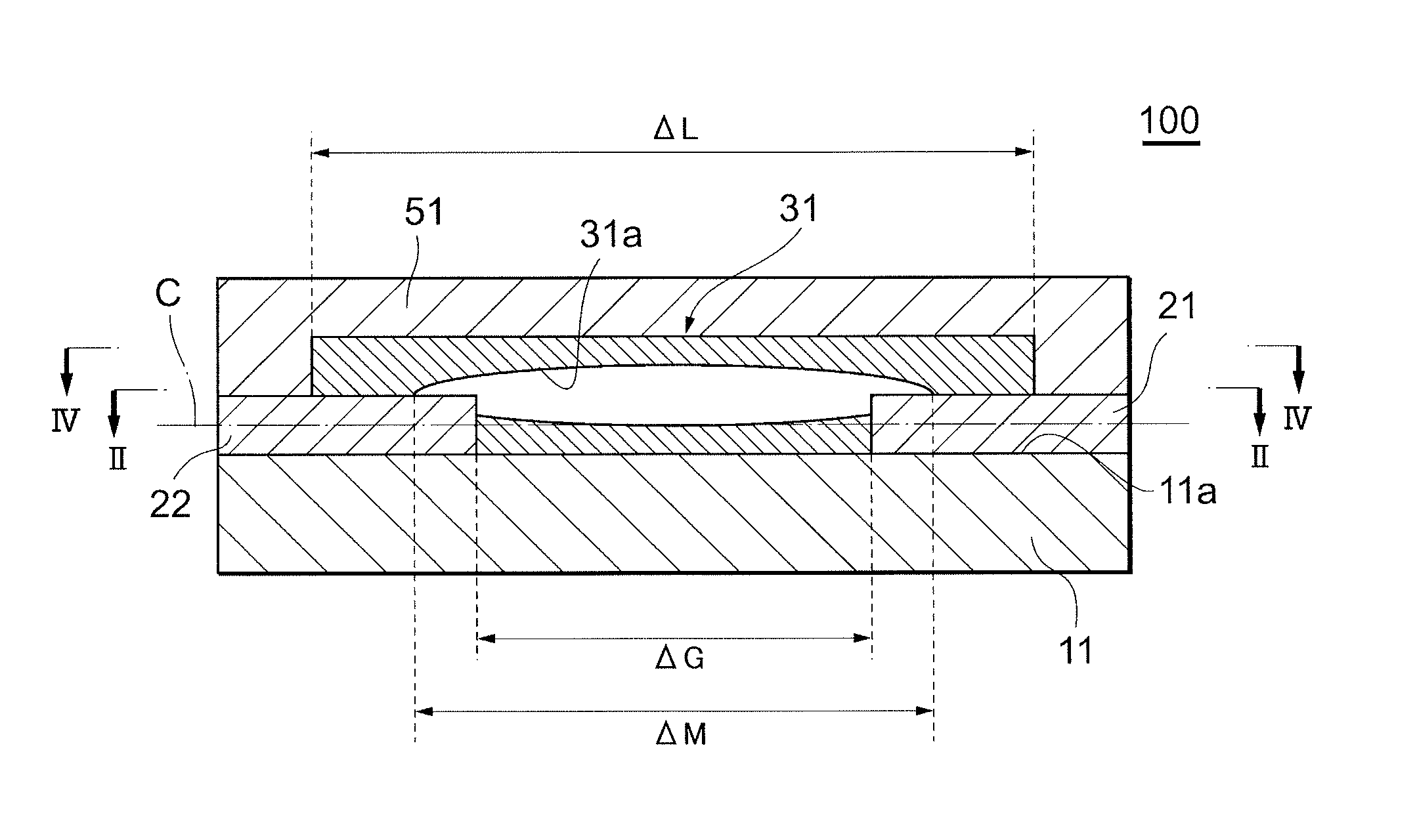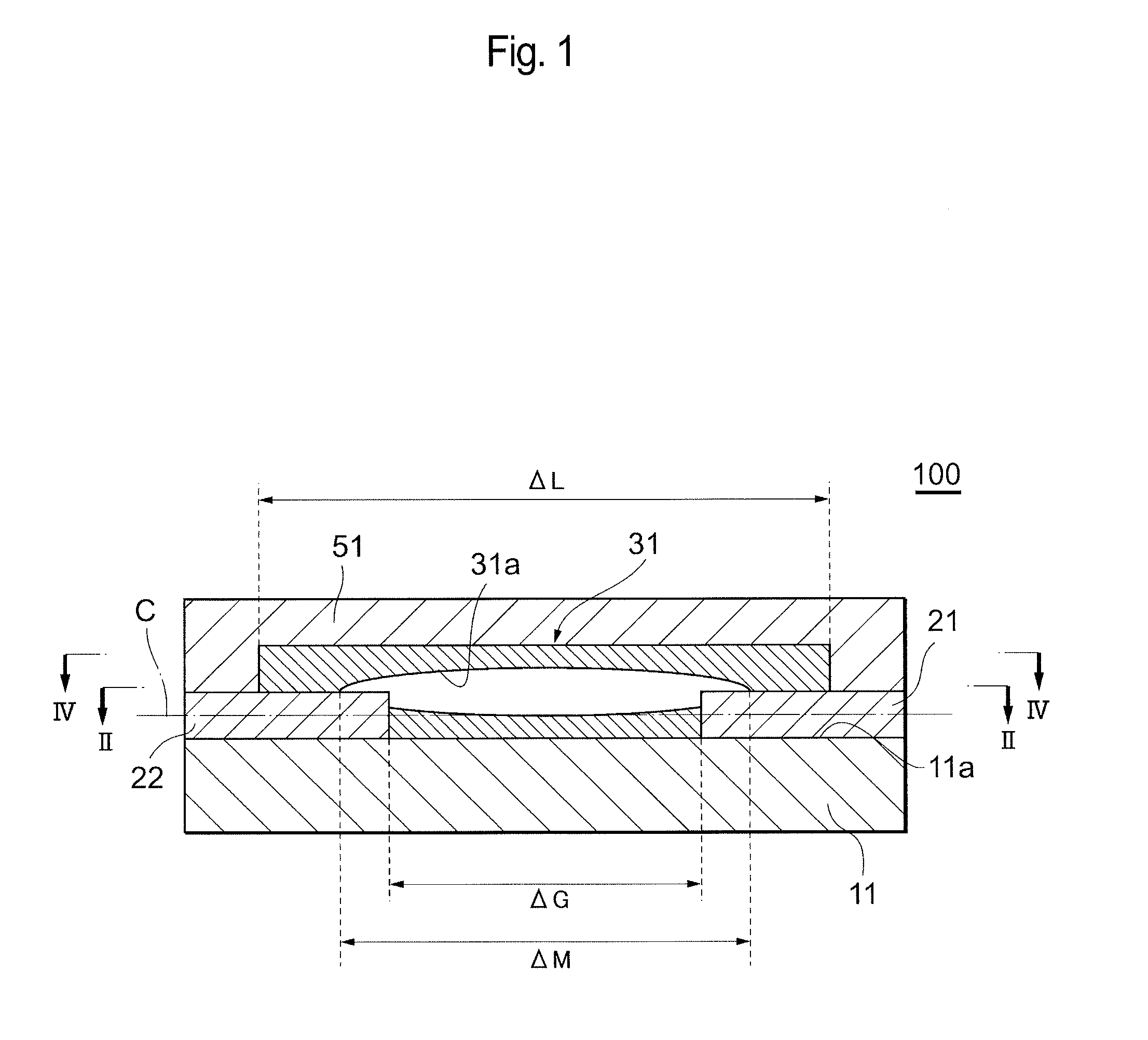ESD protection device
a protection device and shielding technology, applied in the direction of overvoltage protection resistors, emergency protective arrangements for limiting excess voltage/current, spark gap details, etc., can solve the problems of electronic components being protected, overvoltage typified, electronic apparatus becoming an important technical problem, etc., to achieve excellent discharge properties, small electrostatic capacitance, and high durability
- Summary
- Abstract
- Description
- Claims
- Application Information
AI Technical Summary
Benefits of technology
Problems solved by technology
Method used
Image
Examples
first embodiment
[0042]FIG. 1 is a schematic sectional view schematically showing an ESD protection device in the present embodiment, and FIG. 2 is a sectional view taken along the line II-II in FIG. 1.
[0043]An ESD protection device 100 includes an insulating substrate 11, paired electrodes 21 and 22 disposed on this insulating substrate 11, a discharge induction section 31 disposed between these electrodes 21 and 22, terminal electrodes 41 (see FIG. 7) electrically connected to the electrodes 21 and 22, and an insulating protection layer 51 formed so as to cover the discharge induction section 31. The discharge induction section 31 is composed of a porous body, in which micropores are discontinuously scattered, and has a hollow structure having at least one or more hollow sections 31a and 31b. Here, the paired electrodes 21 and 22 are located so that their tip portions are exposed in these hollow sections 31a and 31b. In this ESD protection device 100, the discharge induction section 31 functions a...
example 1
[0067]First, as shown in FIG. 5, a green sheet (manufactured by TDK Corporation) obtained by sheeting a material composed mainly of Al2O3 and a glass component was prepared as an insulating substrate 11, and an Ag paste was printed with about a thickness of 20 μm on one insulating surface 11a of the insulating substrate 11 by screen printing to pattern-form paired band-like electrodes 21 and 22 arranged opposite each other. For the paired electrodes after the printing, the length and width of the electrodes 21 and 22 were 0.5 mm and 0.4 mm respectively, and the gap distance ΔG between the electrodes 21 and 22 was 30 μm.
[0068]Next, as shown in FIG. 6, a discharge induction section 31 was formed on the above insulating substrate 11 and on the above electrodes 21 and 22 by the following procedure.
[0069]First, 10 vol % of glass particles composed mainly of SiO2 (manufactured by Nihon Yamamura Glass Co., Ltd., product number: ME13) as an insulating inorganic material 32, 30 vol % of Al2O...
example 2
[0073]A discharge induction section 31 that was composed of a porous body, in which micropores 34 were discontinuously scattered, and had a hollow structure having one hollow section 31a was fabricated, and an ESD protection device 100 in Example 2 was obtained, by performing operations similar to those in Example 1 except that the resin paste was screen-printed in an oval spherical shape at only one place during the screen printing of the resin paste.
PUM
 Login to View More
Login to View More Abstract
Description
Claims
Application Information
 Login to View More
Login to View More - R&D
- Intellectual Property
- Life Sciences
- Materials
- Tech Scout
- Unparalleled Data Quality
- Higher Quality Content
- 60% Fewer Hallucinations
Browse by: Latest US Patents, China's latest patents, Technical Efficacy Thesaurus, Application Domain, Technology Topic, Popular Technical Reports.
© 2025 PatSnap. All rights reserved.Legal|Privacy policy|Modern Slavery Act Transparency Statement|Sitemap|About US| Contact US: help@patsnap.com



